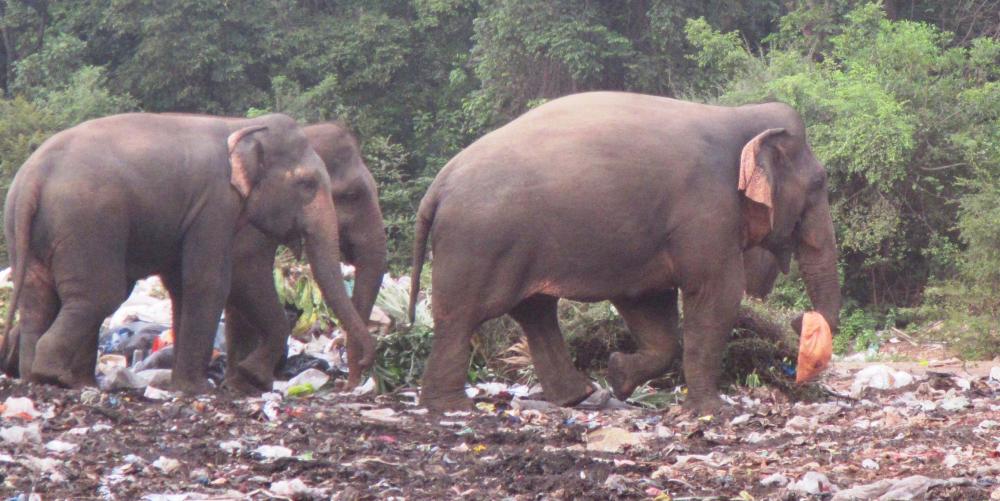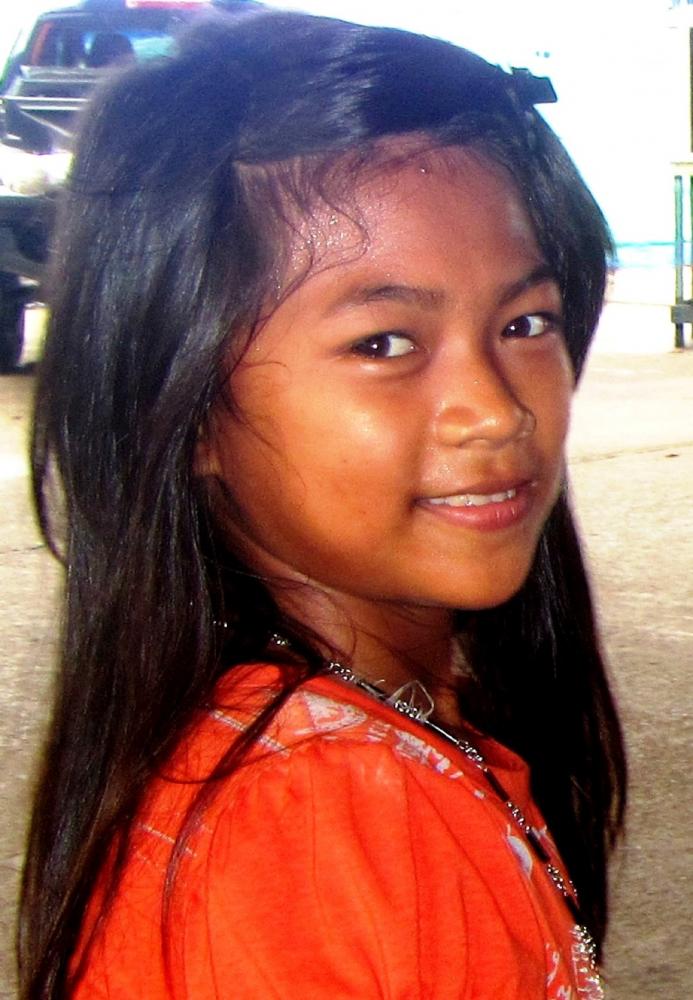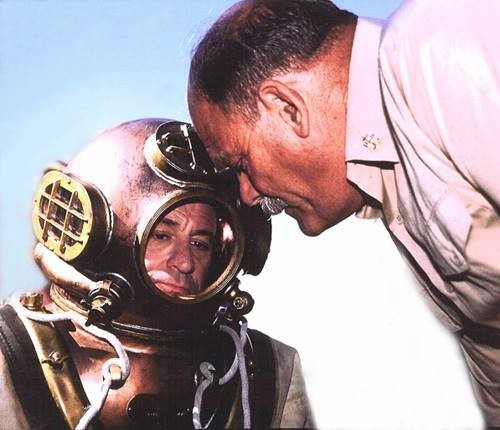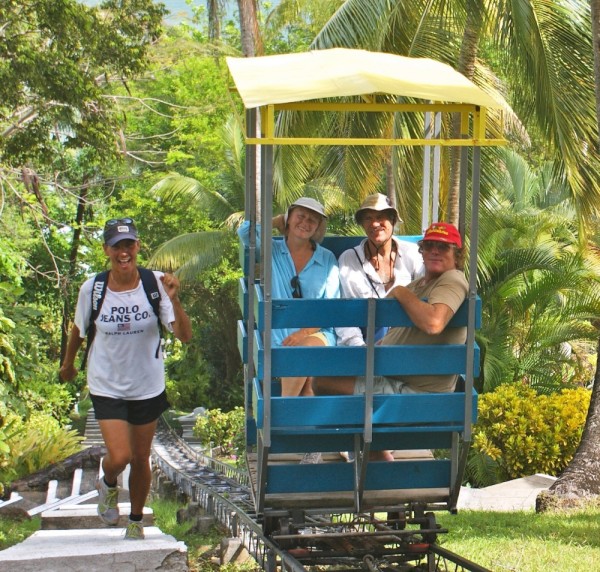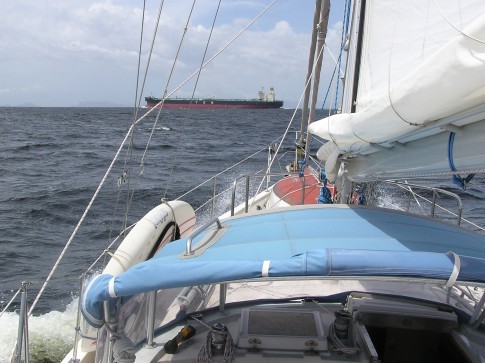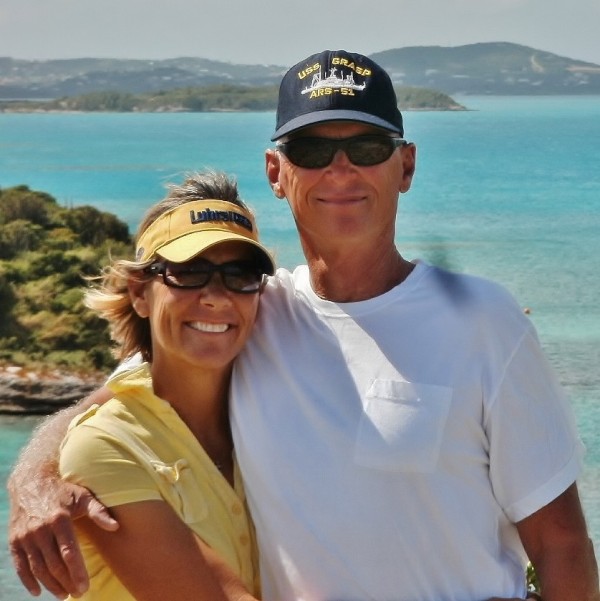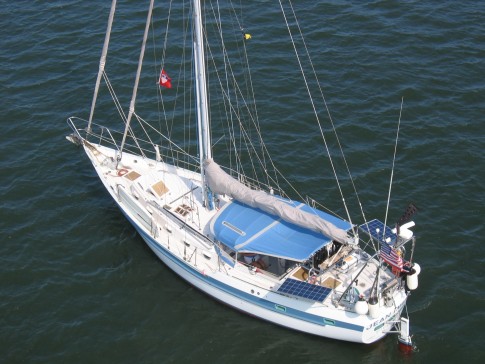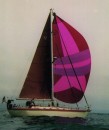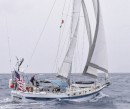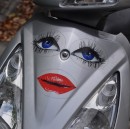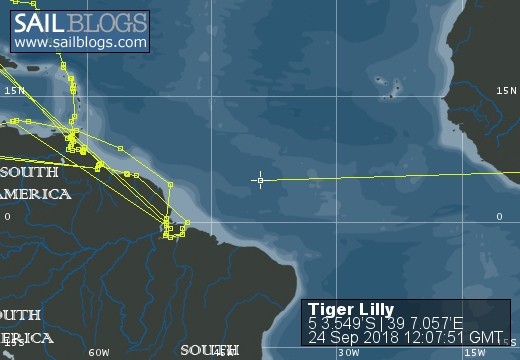
S/V Tiger Lilly
Rig heavy, reef early, and pray often; for God does not assure us an easy passage, but He does promise a safe anchorage...
25 May 2018 | TRINCOMALEE, SRI LANKA
02 January 2018 | Clan Jeti Anchorage, Georgetown, Penang Island, Malaysia
03 November 2016 | Singapore, Southeast Asia
02 October 2016 | Kumai River, Borneo
24 August 2016 | Rindja Island, Indonesia
22 July 2016 | Fannie Bay, Darwin, Northern Territory, Australia
14 June 2016 | Pancake Creek, Queensland, Australia
13 June 2016 | Pancake Creek, Queensland, Australia
11 June 2016 | Burnette Heads, Queensland, Australia
07 June 2016 | Mooloolaba, Queensland, Australia
11 May 2016 | Colmsie, Brisbane River, Queensland, Australia
23 December 2015 | Brisbane, Australia
13 August 2015 | Whangarei, New Zealand
07 August 2015 | Whangarei, New Zealand
23 July 2015 | Whangarei, New Zealand
12 April 2015 | Whangarei, New Zealand
11 February 2015 | Whangarei, New Zealand
25 January 2015 | Whangarei, New Zealand
24 September 2014 | BORA BORA, French Polynesia
23 September 2014 | Bora Bora
TIGER LILLY - SURINAME
13 August 2013 | Domburg, Suriname
Tom and Lilly
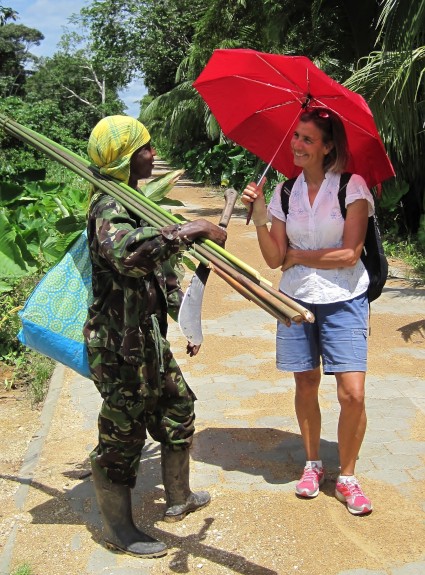
WHY SURINAME?
The theme for our 2013 cruising in Tiger Lilly is exploring the tropical rivers of South America as we work our way south from the Caribbean to Uruguay - and Suriname is right along that route. Guiana is an Amerindian word for many waters, and Suriname (the former Dutch Guiana) is in the heart of the Amazonian region on the northeast watershed of South America. We loved the natural beauty and remoteness of Eastern Venezuela's Rio Orinoco Delta. We were humbled by the vastness, colorful grandeur, and sheer power of Guyana's mighty Essequibo River. But we had been off the beaten track cruising by ourselves since we left Trinidad in April, and as we sailed into the mouth of the Suriname River in June we had high hopes of seeing other sailboat cruisers and civilization. Our first impression of Suriname was the Suriname River itself; the NAVAIDS on the river were First World quality - the channel was clear and well marked. It was apparent that MAS (the Maritime Authority of Suriname) manages their river very professionally. As we sailed up-stream towards the capital city of Paramaribo the commercial vessels we passed and the maritime facilities lining the banks of the river told of the rich natural resources of Suriname; sawmills busily processing huge hardwood logs, the tugs and barges used to transport bauxite ore being dry-docked and repaired, and construction rigs working along the Paramaribo Harbor banks building a new sea wall. As we approached Paramaribo a Marine Police patrol boat hailed us and came alongside Tiger Lilly. We were surprised that Officer Gerrit looked as though he was from Southeast Asia; and we soon learned that in fact his ancestors were from the Indonesian Island of Java - as were many other Surinamese. We were about to enter a cultural potpourri that spans the globe from China, to the Indian sub-continent, to the Spice Islands, to Northern Europe, to Equatorial West Africa, all settled into the tropical rainforest and jungles of the South American continent. This eclectic mix of people would delight us for the next month or so. After an overnight anchorage in Paramaribo to get the timing of the ebb tide and daylight coordinated for our journey up-river, the next morning we motored about 9 miles to the little community of Domburg Landing, the official place for yachts to anchor on the Suriname River. All along the banks of the river we saw beautiful homes, thriving businesses, and people working hard - even before we stepped ashore it was obvious to us that Suriname was a dynamic place. As we approached Domburg we were excited to see other cruising sailboats - we counted 5 masts as we rounded the final bend in the river. When we stepped ashore at Domburg Landing our first impression of this little country community was how clean and neat it was - and we were all the more eager to see this place they call Suriname.
The Tourist Board calls Suriname "The Green Caribbean" - but we are pretty sure that we were well south of the Caribbean Sea and were cruising down the northeast coast of South America; that is until we got to Domburg, and both the land and the people looked a lot like Southeast Asia. After independence from the Dutch in the mid-70's, Suriname had a rocky start both economically and democratically, but the people have come together and created a clean, safe, beautiful place to live and work. The ties to Mother Holland are still strong, and obviously the basis of their prosperity and capital investment. We did hear a lot of talk by the Dutch ex-pats regarding drug trafficking - apparently Suriname is a major corridor for this poisonous contraband from Columbia and Bolivia into Europe. Suriname has a very diverse population made up of many races of people: Amerindians - the original inhabitants of northeastern South America; Maroons - African slaves who escaped to the bush in the Eighteenth and Nineteenth Centuries; decedents of African plantation slaves freed by Dutch emancipation in1863; Creoles - of mixed African and Dutch descent; East Indians - from India; Chinese - differentiated by the "old" pre-independence Chinese, and the "new" Chinese who came to Suriname after the mid-70's; Caucasians - mostly Dutch with a few other cats and dogs thrown in; and the Hindustani Javanese. (See our previous Blog on Sapto the JAVA MAN which tells the story of the Javanese indentured servants who replaced the African slaves). No single ethnicity is large enough to impose its will on the others, and this tropical salad bowl of mixed cultures seems to rule by consensus and live in harmony. The Surinamese express their pride of country by the ubiquitous "I LUV SU" tee shirts. The Dutch language is taught in school, and is the official language of Suriname; but Talkie-Talkie (a mixture of several languages based on the way the early white settlers spoke with the Amerindians, and the African slaves) is a common way to communicate anywhere in the Guyane. Although the police are reserved and strict, we found them to be cordial, and we felt safe everywhere we went. However, we noticed that the common folk of Suriname keep their distance from the police. We used the local bus system, and were impressed with the gentle way the people treated each other (and the way they treated us with our bulky back packs and bags full of groceries) in these completely packed public vehicles. Even the aisles of the busses were utilized by flip seats down the middle; requiring a major shift of passengers whenever anyone in the back of the bus reached their stop. Domburg is a little country community; and the residents all know and look out for one another. We did not find it necessary to lock the boat or the dinghy while we were in Domburg. (We can just imagine all the Coco-Nutters on the Caribbean Safety and Security SSB Radio Net going tisk-tisk "Lock it or loose it!") It was such a refreshing change from the Caribbean not to be blasted 24-7 with Thug Music from ashore, and to hear a community go quiet at 2200 when these hard working folks went to bed. Waking up to the fierce growl of the howler monkeys and the distinctive call of the kiskadee (which phonetically mimics their name) was the norm on the Suriname River. We grew to LUV SU 2!
The anchorage off Domburg Landing was where we spent most of our time while we were in Suriname. Domburg is a typical river landing community, and was once the site of a stately Dutch Colonial plantation (now a soccer field). The environs are a checkerboard of drainage canals dug with slave labor in the Nineteenth Century, and fitted with ingenious sluice gates which utilize the tidal differences on the river to drain the land. The Dutch are quite clever in reclaiming land from the sea. The ambiance of the landing is characterized by the welcoming "Old Grandfathers" (huge shade trees) which line the sand lane from the dock on the river out to the road. These stately old trees can be seen for miles as one approaches the landing. The dock at this river landing is actually an inclined ramp to accommodate the 6 to 8 foot tides on the Suriname River. SAM (the Suriname Maritime Authority) has designated Domburg as the official anchorage for yachts on the Suriname River. We heard different reasons for this decision, including: the President of Suriname did not want to see Dutch yachts present on Paramaribo's riverfront, they were a reminder of the colonial era; the Port Captain wants to keep the Paramaribo inner harbour clear for commercial traffic; and the Maritime Police prefer to have the foreign yachts in a single location. Probably elements of all these, and other, reasons are the basis for this decision. We were told that SAM allows yachts to anchor in front of the Hotel Torarica on the east end of the Paramaribo Harbour for a short period of time, and then will send the Marine Police out to move them up-river to Domburg - which is where we preferred to be anyway. Each evening the Dutchmen ex-pats (a friendly fellow named Huib, the owners of the Four Brothers Fishery, and assorted local retirees) and the yachties from the anchorage assemble at the Landing around 1700 for sundowners - a most enjoyable time. Gregarious Huib is in the process of building a marina on the east side of the landing. His marina will feature floating docks to accommodate yachts and dinghies - a really important amenity considering the tidal range on the river, and the rough condition of the shore. When we left Domburg in July of 2013 the project was well along, and Huib expects it to be complete by New Years 2014. He plans to have all the amenities needed by cruisers, and reasonably priced as well. He understands cruisers and he seems to enjoy their company; we expect that his marina will significantly upgrade Domburg / Suriname as a yachting destination. Huib and his wife Irene are very extraordinary people - ask him to tell you the story about how a crooked Nigerian priest had him put in prison in West Africa when he was there donating a school for the poor children. It seems that no act of kindness and generosity goes without its reward. But this strong-willed big-hearted Dutch businessman / farmer is not to be discouraged; he is returning to West Africa in the coming year - with only love in his heart for the people - to finish the school he started. For us, meeting Huib and Irene Oskam was certainly a highlight of our visit to Suriname. While we were at Domburg, the National Day of Unity was celebrated on 1 July. Called Keti Koti - the breaking of chains - it marks the Dutch emancipation of slavery and it is celebrated by all the various Surinamese cultures. Also in July, the annual International Swimming Marathon - a major open-water race from Domburg to Paramaribo harbour - was conducted. Both of these events were enjoyable additions to our Suriname experience.
SURINAME IMMIGRATION CHECK-IN (Customs clearance for visiting yachts is not required if your stay is less than 90 days, and not for the purpose of conducting business.)
Our first stop as we came ashore was to get some cash for transportation costs and Tourist Card fees at the ATM machine at Cheryl's Enterprise Fuel Station and Supermarket in Domburg. This is an RBC (Royal Bank of Canada) ATM machine and it accepted our USA Visa debit card. (The exchange rate in June 2013 was 3.25 SRD / US Dollar.) Later, we found out that the ATM machines which belong to the local banks (and the credit card machines in local businesses) would not accept our USA Visa cards (debit or credit). We made all of our Suriname monetary transactions in cash which we obtained from RBC ATM machines (there are several locations in Paramaribo). For check-in we took the bus from Domburg (2.5 SRD per person per way), and then used the cruiser-recommended Tourtonne's Taxi to make the rounds for checking-in. (Tourtonne's Taxi - telephone 475734 or 425380, they have a special business rate of 30 SRD per hour, we liked the service from drivers #29 Andreas and #43 Luciana - you can ask for them specifically). By the time we were ready to check-out, we were familiar enough with Paramaribo and environs that we used the more economical public bus system. Get off the Domburg "PDP" bus at the end of the line on Maagdenstraat, walk about 3 blocks west to Steenbakkerlistraat, take a left and walk down the row of waiting busses and board a #8, and tell the driver you want to get off at the Foreign Immigration Police Station on Mr.Jaggernathlarchmonstraat out on the western edge of the city. Lilly sez: HOW BOUT THOSE DUTCH STREET NAMES!
A) Foreign Police (Vreemdelingen Polite) - The Ministry of Public Services Special Police Office #167 Jaggernath Lachmon Street (out on the western edge of Paramaribo), present 3 copies of your Crew List (one for the Immigration Police, one for the Visa Office, one to keep in your possession), they will stamp all three copies of your Crew List and retain one copy at the Immigration Office. The initial stamp is good for 30 days, and if you desire to stay in Suriname past that, then ALL crew members must return every 30 days for an extension stamp (max of 90 days). The Immigration Police sergeant was very welcoming; but be sure you dress appropriately, or you may be sent all the way back to Domburg to change.
B) Visa Office - The Ministry of Foreign Affairs at the corner of Lim A Po Street and Watermolen Street (downtown Paramaribo), for a Tourist Card (not for business - that will require a Visa), pay 20 Euro or 25 USD (no SRD accepted - figure that one out), and they will retain one copy of your stamped Crew List. There is a money changing facility in the downtown Post Office to buy the required Euro or USD if you do not have that currency. A Visa is not required for citizens of the USA, Canada, and France (and probably many other countries, these are the ones we know for certain).
C) Return to the Foreign Police - they will stamp your passport and your just-purchased Tourist Card and you are done. Admittedly, this is one of the more complex and lengthy check-in processes we have experienced; however, the officials were friendly, and the taxi drivers gave us a nice talking-tour of Paramaribo as we drove from place to place.
PARAMARIBO
By the time we got to Suriname we were ready to see the bright lights of civilization again. Suriname's capital city of Paramaribo was a delightful place to tour and shop. The city is clean, safe, and friendly - like all the areas of Suriname we visited. The bus ride from Domburg was enjoyable, but packed. The key to getting a ride into town is to get out to the bus stop before 0700, after that most busses will be full of commuters, and it will likely be well past mid-morning before a bus with an available seat comes by Domburg. Most of the busses are privately operated and as soon as they are full, they become express runs directly into Paramaribo. One tactic to get a seat is to walk west down the road (towards Paramaribo) to Cheryl's Enterprise Fuel Station and Supermarket, and board an OUTBOUND bus. After about 20 minutes travel away from Paramaribo the bus will turn around, and quickly fill up with passengers. By the time you arrive back at Domburg you have had a nice ride into the countryside, and have a seat on the bus; as you pass back by Domburg Landing don't forget to waive at the cruisers who slept in and are standing by the roadside! The Domburg "PDP" bus terminates on Maagdenstraat in downtown Paramaribo - we used the Gandhi statue at the end of the block as a landmark to find our way back. One note of caution: be back to the bus pick-up point before 1700, as that is approximately when the last bus leaves for Domburg. Smart money will not cut that time too close as the busses leave when they are full of passengers, NOT at any scheduled time.
Things to do in Paramaribo: Firstly, it is both easy and safe to walk around downtown Paramaribo during the day. There is a great Tourist Office in Paramaribo - it is located in front of Fort Zeelandia in the old historic district at Waterkant #1 (www.visitsurinameonline.com). We thoroughly enjoyed our self-paced walking tour through the Government District, and the restored Historic area. (Lilly sez; Well, I am not sure I would use the word "pace" anywhere around one of Tom-Tom's walking tours - especially the part where he reads EVERY SINGLE FLIPPEN WORD, on EVERY historical placard he can find. WHO CARES what they did 200 YEARS AGO, what I want to know is WHERE'S LUNCH!) We enjoyed lunch at restaurant La Cuisine; they offer wonderful Italian food and Surinamese dishes, free Wi-Fi, and comfortable seating (walk past Sainte-Peter and Sainte-Paul Kathederal on Henckarronstraat, turn right on Tourtonnelann, and La Cuisine is down one block at the corner of Tourtonnelann and Koninginnestraat). Chef Max Kempenaar, a Rotterdam Culinary School graduate with over 50 years of cooking experience, absolutely lights up the room when he smiles with his twinkling eyes. The Tourtonnelaan TULIP grocery store (one of the best in Suriname) is right down the street from the La Cuisine; so have a nice lunch with Max at La Cuisine before shopping. Max lives in Domburg, and it turns out we were anchored right off his home. He quickly became our friend - it is just so easy to like him. Just before we departed Suriname he cooked the crew of Tiger Lilly a good-bye meal at his home; our special feast included shrimp, crab legs, lamb chops, and ocean fish that tasted absolutely delicious. In the ongoing cruiser's search for Internet we found these places to check our email while in Paramaribo: there is a McDonald's right around the block from the bus stop and we overdosed on ice cream while surfing the Net. In the lobby of the Krasnapolsky Hotel (Domineestraat # 39) there is a Rituals Coffee shop, with a sidewalk cafe. The information booth in the lobby will give you a free password, if you buy a coffee. The patio cafe across the street from Hotel Torarica has Wi-Fi available to its customers; we bought breakfast - nothing is really free is it? The lobby of the Torarica Hotel was quite comfortable in the European style, and they had Internet; the clerk at the information desk kindly gave us the password. If you desire to anchor off the Torarica Hotel and use their facilities (dinghy dock, pool, showers, Internet) the fee is $50 USD per day - way too steep for Tiger Lilly! (Lilly sez: My Tom-Tom has deep pockets and short arms.) There is a large Town Market down on the river front, but we preferred to buy our fresh provisions in Domburg, and have less to carry back on the crowded bus. They have a small farmer's market twice a week at the Domburg Landing, and we found that to be the easiest way to buy fresh provisions. Shopping in Paramaribo was quite good; there are plenty of stores to choose from, and the prices seem reasonable - but the Dutch labels were a challenge for us without a Dutch dictionary. There is a yacht chandlery located in Paramaribo which caters principally to the local power boaters. As you ride the bus into town, just before the route intersects the traffic circle at the approach to the harbour bridge, the road runs along a busy industrial canal. This chandlery is located on that canal, and the bus driver will stop there if you ask him. For us, Paramaribo was a treat.
CRUISING NOTES
Our July sail from the Essequibo River in Guyana to the mouth of the Suriname River was pretty much as we have described in our previous passages down the northeast coast of South America. (See Tiger Lilly's Rio Orinoco Delta and Guyana Blogs.) We tacked back and forth in light (Force 3-4) easterly and east-northeasterly winds between the 10 fathom curve (northwest flowing Guiana Current) and the shallow mud banks off the mangrove forests of the Guyana coast. We had a long tack along the shore as we obliquely closed the coast and the water got shallower, and then a shorter tack out to the deeper water and the northwest setting Guiana Current. On the inshore leg we generally tacked when the fathometer indicated 12 to 14 feet - but with 6 to 7 feet of tide and a shallow gradient on this coast, on some tacks we came closer to the shore than others. The fishing boats, and their nets were our greatest challenge on this passage, but as long as we had daylight, and we could see the black flags marking the nets we were able to maneuver around them. The up-current up-wind (easterly) end of the net is usually marked with double black flags, and the fishing boat hangs off the down-current down-wind (westerly) end of the net. Unfortunately, the fishing boats, and their nets are not lit; and we NEVER cross the bow of an anchored fishing boat, day or night. We only had to anchor offshore one night on the so-called "sling mud," and the other two nights of the passage the wind backed slightly towards the northeast and the tacks worked out that during the hours of darkness we were in deeper water where the nets were not an issue. The trade-off is to either anchor for the night, and make zero miles, or stay out in deeper water bucking the current and make some miles. (Lilly sez: I vote for my bunk and SLEEP, thank you very much!) It was 280 miles (tacking) from anchor up at Enterprise Stelling on the Essequibo River, Guyana to anchor down in the Paramaribo Harbour anchorage on the Suriname River. As we neared the mouth of the Suriname River the fishing activity was greater, and we had to be very careful to stay out of the nets, with both of us on close watch as we approached the Suriname River sea buoy. The buoys on the Suriname River are moved to conform to the river bottom; so be advised to follow the buoy's - not the electronic charts. MAS (the Maritime Authority of Suriname) has done a first class job of installing the NAVAIDS on the river - it is an easy body of water to navigate. As we came in we were boarded by Suriname Marine Police in the vicinity of Voorburg. They were quite friendly, inspected our boat papers and our Guyana zarpe, and we enjoyed visiting with them.
DOMBURG ANCHORAGE
We anchored just up-river of Domburg in 33 feet of fast moving current (we saw 3 knots at times) - so bring good ground tackle. Approximately two hours after the published low tide at Paramaribo is the slack before flood at Domburg. The slack before ebb at Domburg is close to the predicted high tide at Paramaribo. (Lilly sez: We understand, that this is gobbley-gook to you Earth People, but it is important information to a sailor anchored in the tidal stream on the river.) We had difficulties with two boats in the anchorage (a newly commissioned Dutch racing yacht, and predictably, an American power trawler) because they did not understand the physics of strong currents, reversing tides, differences in boat resistance (to both wind and water), and the way the boats aimlessly drift in the combination of the early morning slack wind and slack current. Anchoring in the fast running tidal streams of these tropical rivers requires lots of scope and lots of room between boats. Huib will have moorings installed off his marina in the next few months for those challenged by these basic principles, or for those vessels which choose to carry light-weight ground tackle. He showed us the hardware he is using for his mooring system and it appeared to be substantial. Huib does everything first-class and we would certainly trust anything he installs. Domburg is a good place to leave your boat on a mooring and fly out. Economical air fares can be found from Paramaribo to North America and Europe through connections in the ABC Islands in the Netherland Antilles. We were told that there is a lot of debris in the river directly off the end of the Domburg Landing; to avoid a fouled anchor it is recommended to stay well clear of this area. (We anchored in the usual area recommended, and still came up with quite a mess - and old permanent mooring - when we picked up our anchor to leave.) With 6 to 8 feet of tide, landing the dinghy can be a challenge - actually landing is easy, it is getting back off in a few hours that can be difficult. The "beach" at the Domburg Landing is full of rocks, sunken logs, old pilings, and broken glass - we always wore our Crocs to land and launch the dink. Huib's Harbour Resort Domburg (info@overinteren-tropen.com telephone 0031-637029967 or 00597-8726198) will soon be a reality, and it will eliminate the only downside we saw in Domburg - landing the dink. The marina will be complete by the end of 2013 and will have available: a floating dinghy dock, 12 mooring balls, boat slips with finger piers on a floating pontoon, restaurant, toilets and showers, potable water on the dock, and perhaps a swimming pool. Huib took our empty LP gas tank to the fill station and returned it full. You pay by the kilo, and a 20 pound American style bottle cost 50 SRD. They have most types of LPG fill nozzles available. The Domburg Online Internet Cafe (which is not actually a cafe) provided Internet access which we could receive aboard Tiger Lilly in the anchorage. They have two types of service available, slow and fast; but the slow is so very slow that it is not worth the money. The fast service cost 8 SRD per hour, and 50 SRD per week. The Domburg Online Internet Cafe doubles as the local Domburg Post Office - however, the hours are unpredictable. There are multiple "supermarkets" (small family grocery stores) in the Domburg area: Chengxin Supermarket, at Domburg Landing facing the road; Cheryl's Enterprise Fuel Station / Supermarket / ATM is just northwest of the Domburg Landing on the road towards Paramaribo; a brand new Chinese supermarket was being built while we were there, just up the road towards Paramaribo beyond Cheryl's Supermarket; and there are other Mom and Pop grocery stores within a 10 minute walk from the Landing. Every day, multiple times a day, the public area around Domburg Landing was raked and picked-up - and they had plenty of trash cans available for us to use. What a refreshing change from our experience with the trash and litter in Guyana. Until Huib gets his marina finished, there is no potable water available for boats anchored off Domburg Landing. However, there was so much rain while we were in Suriname, we collected plenty of rain water and our tanks were usually close to topped-off. (Lilly sez: Yeah! Showers every night in Suriname!) Security - Domburg is a safe place for yachties - we heard of no security problems while we were there. Local Domburg folks say that out in the country folks watch out for each other. As are most cruisers, when the sun sets we are usually aboard Tiger Lilly, or within sight of her aboard another boat in the anchorage - and security problems are usually minimal under these conditions. While we were in Suriname we needed a snail-mail drop, and on the recommendation of fellow cruisers we used: Laparkan Air and Ocean Shipping in Paramaribo (Henck Arronstraat #144, www.laparkan.com, email thalicia.wezer@laparkan.com, telephone office (597) 680-0182/3/4/6, cell 07701431 and (597) 832-4283). Thalicia Wezer was so very helpful, and like many of the business people we met in Suriname, she became a personal friend. They provide surface, air freight, and courier services between their offices in Miami, Amsterdam, and Paramaribo. We heartily recommend Thalicia and Laparkan. As do most businessmen in Suriname, Huib maintains both Dutch and American mail drop boxes, and he will likely make this part of what he offers once his marina is up and running. There is a FedEx office in the Hermitage Mall (out towards the Immigration Police Office on the western outskirts of Paramaribo), but it is not a very convenient location - if you use them be sure to take your passport, as that is the only identification they will accept from foreigners. The Four Brothers Fishery, west of Domburg on the waterfront, is a good place to start if you need mechanical or electrical repairs; also, Huib has a lot of contacts in Paramaribo. The Four Brothers Fishery maintain a fleet of fishing trawlers, and the brothers are all quite friendly and helpful to cruisers. Fressa's Fancy Food (bright orange and yellow colored stand, Frederick is the owner) at the Domburg Landing was a great place to meet and greet, see and be seen, and wait for the rain to let up. Often the Dutchmen and yachties would hold sundowners here. Frederick has some laminated cruiser information sheets (in various languages) available to lend out to visiting yachties. A short walk down the road outside of Domburg (southeast, away from Paramaribo) is the Mit Shiv Javanese restaurant - a tasty and economical place to eat lunch. As do most Surinamese restaurants, they have chicken, rice, pork, and noodles - and any permutation or combination thereof. Lilly sez: Beware! The hot sauce will make you want to tear your tongue out. Warning: all cardinal and inter-cardinal directions we give in this set of cruising notes are subject to HUGE errors. Domburg is located near an oxbow bend on a circuitous river - we NEVER knew which DIRECTION we were facing; until evening when we were treated to absolutely stunning sunsets, and even then, we were always surprised in the direction the brilliant orange orb chose to settle!
UP-RIVER CRUISE - For a change of scenery we motored for two and a half hours up-river to the head of navigation on the Suriname River for a sailing vessel at the low-clearance bridge for the bauxite transfer trucks. We anchored just down-river from the bridge at 5-36.89N 055-02.58W, had a bit of a walk-about on the east bank, and then returned down-river on the ebb tide for an anchorage at Waterland. After exploring the Waterland area we continued down-river to the Rio Pikien (just 4 miles up-river from Domburg). We anchored in the Suriname River at 5-41.51N 55-01.64W, and took the dink up the Rio Pikien exploring. The Rio Pikien was wild and interesting: we saw monkeys and lots of bird life. It was similar to our experience exploring the canos in Venezuela's Rio Orinoco Delta. We rowed up the cano, and then drifted back down with the current. When anchoring on the east bank of the Suriname River stay close to the shore and show an anchor light since there is a lot of commercial barge traffic on the river, and those boys like to run the banks close. A nice addition to this mini-cruise would be a stop at White Beach for a refreshing river swim off their sand beach.
All in all, we think that Suriname is a great destination for yachts cruising the northeast coast of South America. We certainly profited by getting to know a bit about this diverse culture and their country, carved out of the rain forest and jungle. We have posted several pictures (with captions) of our visit to Suriname in the PHOTO GALLERY on this blog. If you click on the PHOTO GALLERY hyperlink in the upper right corner of this page, and follow the logic tree: Main / Ports of Call / South America / Suriname, you will soon be cruising up the Suriname River with Tiger Lilly. See you there!
The theme for our 2013 cruising in Tiger Lilly is exploring the tropical rivers of South America as we work our way south from the Caribbean to Uruguay - and Suriname is right along that route. Guiana is an Amerindian word for many waters, and Suriname (the former Dutch Guiana) is in the heart of the Amazonian region on the northeast watershed of South America. We loved the natural beauty and remoteness of Eastern Venezuela's Rio Orinoco Delta. We were humbled by the vastness, colorful grandeur, and sheer power of Guyana's mighty Essequibo River. But we had been off the beaten track cruising by ourselves since we left Trinidad in April, and as we sailed into the mouth of the Suriname River in June we had high hopes of seeing other sailboat cruisers and civilization. Our first impression of Suriname was the Suriname River itself; the NAVAIDS on the river were First World quality - the channel was clear and well marked. It was apparent that MAS (the Maritime Authority of Suriname) manages their river very professionally. As we sailed up-stream towards the capital city of Paramaribo the commercial vessels we passed and the maritime facilities lining the banks of the river told of the rich natural resources of Suriname; sawmills busily processing huge hardwood logs, the tugs and barges used to transport bauxite ore being dry-docked and repaired, and construction rigs working along the Paramaribo Harbor banks building a new sea wall. As we approached Paramaribo a Marine Police patrol boat hailed us and came alongside Tiger Lilly. We were surprised that Officer Gerrit looked as though he was from Southeast Asia; and we soon learned that in fact his ancestors were from the Indonesian Island of Java - as were many other Surinamese. We were about to enter a cultural potpourri that spans the globe from China, to the Indian sub-continent, to the Spice Islands, to Northern Europe, to Equatorial West Africa, all settled into the tropical rainforest and jungles of the South American continent. This eclectic mix of people would delight us for the next month or so. After an overnight anchorage in Paramaribo to get the timing of the ebb tide and daylight coordinated for our journey up-river, the next morning we motored about 9 miles to the little community of Domburg Landing, the official place for yachts to anchor on the Suriname River. All along the banks of the river we saw beautiful homes, thriving businesses, and people working hard - even before we stepped ashore it was obvious to us that Suriname was a dynamic place. As we approached Domburg we were excited to see other cruising sailboats - we counted 5 masts as we rounded the final bend in the river. When we stepped ashore at Domburg Landing our first impression of this little country community was how clean and neat it was - and we were all the more eager to see this place they call Suriname.
The Tourist Board calls Suriname "The Green Caribbean" - but we are pretty sure that we were well south of the Caribbean Sea and were cruising down the northeast coast of South America; that is until we got to Domburg, and both the land and the people looked a lot like Southeast Asia. After independence from the Dutch in the mid-70's, Suriname had a rocky start both economically and democratically, but the people have come together and created a clean, safe, beautiful place to live and work. The ties to Mother Holland are still strong, and obviously the basis of their prosperity and capital investment. We did hear a lot of talk by the Dutch ex-pats regarding drug trafficking - apparently Suriname is a major corridor for this poisonous contraband from Columbia and Bolivia into Europe. Suriname has a very diverse population made up of many races of people: Amerindians - the original inhabitants of northeastern South America; Maroons - African slaves who escaped to the bush in the Eighteenth and Nineteenth Centuries; decedents of African plantation slaves freed by Dutch emancipation in1863; Creoles - of mixed African and Dutch descent; East Indians - from India; Chinese - differentiated by the "old" pre-independence Chinese, and the "new" Chinese who came to Suriname after the mid-70's; Caucasians - mostly Dutch with a few other cats and dogs thrown in; and the Hindustani Javanese. (See our previous Blog on Sapto the JAVA MAN which tells the story of the Javanese indentured servants who replaced the African slaves). No single ethnicity is large enough to impose its will on the others, and this tropical salad bowl of mixed cultures seems to rule by consensus and live in harmony. The Surinamese express their pride of country by the ubiquitous "I LUV SU" tee shirts. The Dutch language is taught in school, and is the official language of Suriname; but Talkie-Talkie (a mixture of several languages based on the way the early white settlers spoke with the Amerindians, and the African slaves) is a common way to communicate anywhere in the Guyane. Although the police are reserved and strict, we found them to be cordial, and we felt safe everywhere we went. However, we noticed that the common folk of Suriname keep their distance from the police. We used the local bus system, and were impressed with the gentle way the people treated each other (and the way they treated us with our bulky back packs and bags full of groceries) in these completely packed public vehicles. Even the aisles of the busses were utilized by flip seats down the middle; requiring a major shift of passengers whenever anyone in the back of the bus reached their stop. Domburg is a little country community; and the residents all know and look out for one another. We did not find it necessary to lock the boat or the dinghy while we were in Domburg. (We can just imagine all the Coco-Nutters on the Caribbean Safety and Security SSB Radio Net going tisk-tisk "Lock it or loose it!") It was such a refreshing change from the Caribbean not to be blasted 24-7 with Thug Music from ashore, and to hear a community go quiet at 2200 when these hard working folks went to bed. Waking up to the fierce growl of the howler monkeys and the distinctive call of the kiskadee (which phonetically mimics their name) was the norm on the Suriname River. We grew to LUV SU 2!
The anchorage off Domburg Landing was where we spent most of our time while we were in Suriname. Domburg is a typical river landing community, and was once the site of a stately Dutch Colonial plantation (now a soccer field). The environs are a checkerboard of drainage canals dug with slave labor in the Nineteenth Century, and fitted with ingenious sluice gates which utilize the tidal differences on the river to drain the land. The Dutch are quite clever in reclaiming land from the sea. The ambiance of the landing is characterized by the welcoming "Old Grandfathers" (huge shade trees) which line the sand lane from the dock on the river out to the road. These stately old trees can be seen for miles as one approaches the landing. The dock at this river landing is actually an inclined ramp to accommodate the 6 to 8 foot tides on the Suriname River. SAM (the Suriname Maritime Authority) has designated Domburg as the official anchorage for yachts on the Suriname River. We heard different reasons for this decision, including: the President of Suriname did not want to see Dutch yachts present on Paramaribo's riverfront, they were a reminder of the colonial era; the Port Captain wants to keep the Paramaribo inner harbour clear for commercial traffic; and the Maritime Police prefer to have the foreign yachts in a single location. Probably elements of all these, and other, reasons are the basis for this decision. We were told that SAM allows yachts to anchor in front of the Hotel Torarica on the east end of the Paramaribo Harbour for a short period of time, and then will send the Marine Police out to move them up-river to Domburg - which is where we preferred to be anyway. Each evening the Dutchmen ex-pats (a friendly fellow named Huib, the owners of the Four Brothers Fishery, and assorted local retirees) and the yachties from the anchorage assemble at the Landing around 1700 for sundowners - a most enjoyable time. Gregarious Huib is in the process of building a marina on the east side of the landing. His marina will feature floating docks to accommodate yachts and dinghies - a really important amenity considering the tidal range on the river, and the rough condition of the shore. When we left Domburg in July of 2013 the project was well along, and Huib expects it to be complete by New Years 2014. He plans to have all the amenities needed by cruisers, and reasonably priced as well. He understands cruisers and he seems to enjoy their company; we expect that his marina will significantly upgrade Domburg / Suriname as a yachting destination. Huib and his wife Irene are very extraordinary people - ask him to tell you the story about how a crooked Nigerian priest had him put in prison in West Africa when he was there donating a school for the poor children. It seems that no act of kindness and generosity goes without its reward. But this strong-willed big-hearted Dutch businessman / farmer is not to be discouraged; he is returning to West Africa in the coming year - with only love in his heart for the people - to finish the school he started. For us, meeting Huib and Irene Oskam was certainly a highlight of our visit to Suriname. While we were at Domburg, the National Day of Unity was celebrated on 1 July. Called Keti Koti - the breaking of chains - it marks the Dutch emancipation of slavery and it is celebrated by all the various Surinamese cultures. Also in July, the annual International Swimming Marathon - a major open-water race from Domburg to Paramaribo harbour - was conducted. Both of these events were enjoyable additions to our Suriname experience.
SURINAME IMMIGRATION CHECK-IN (Customs clearance for visiting yachts is not required if your stay is less than 90 days, and not for the purpose of conducting business.)
Our first stop as we came ashore was to get some cash for transportation costs and Tourist Card fees at the ATM machine at Cheryl's Enterprise Fuel Station and Supermarket in Domburg. This is an RBC (Royal Bank of Canada) ATM machine and it accepted our USA Visa debit card. (The exchange rate in June 2013 was 3.25 SRD / US Dollar.) Later, we found out that the ATM machines which belong to the local banks (and the credit card machines in local businesses) would not accept our USA Visa cards (debit or credit). We made all of our Suriname monetary transactions in cash which we obtained from RBC ATM machines (there are several locations in Paramaribo). For check-in we took the bus from Domburg (2.5 SRD per person per way), and then used the cruiser-recommended Tourtonne's Taxi to make the rounds for checking-in. (Tourtonne's Taxi - telephone 475734 or 425380, they have a special business rate of 30 SRD per hour, we liked the service from drivers #29 Andreas and #43 Luciana - you can ask for them specifically). By the time we were ready to check-out, we were familiar enough with Paramaribo and environs that we used the more economical public bus system. Get off the Domburg "PDP" bus at the end of the line on Maagdenstraat, walk about 3 blocks west to Steenbakkerlistraat, take a left and walk down the row of waiting busses and board a #8, and tell the driver you want to get off at the Foreign Immigration Police Station on Mr.Jaggernathlarchmonstraat out on the western edge of the city. Lilly sez: HOW BOUT THOSE DUTCH STREET NAMES!
A) Foreign Police (Vreemdelingen Polite) - The Ministry of Public Services Special Police Office #167 Jaggernath Lachmon Street (out on the western edge of Paramaribo), present 3 copies of your Crew List (one for the Immigration Police, one for the Visa Office, one to keep in your possession), they will stamp all three copies of your Crew List and retain one copy at the Immigration Office. The initial stamp is good for 30 days, and if you desire to stay in Suriname past that, then ALL crew members must return every 30 days for an extension stamp (max of 90 days). The Immigration Police sergeant was very welcoming; but be sure you dress appropriately, or you may be sent all the way back to Domburg to change.
B) Visa Office - The Ministry of Foreign Affairs at the corner of Lim A Po Street and Watermolen Street (downtown Paramaribo), for a Tourist Card (not for business - that will require a Visa), pay 20 Euro or 25 USD (no SRD accepted - figure that one out), and they will retain one copy of your stamped Crew List. There is a money changing facility in the downtown Post Office to buy the required Euro or USD if you do not have that currency. A Visa is not required for citizens of the USA, Canada, and France (and probably many other countries, these are the ones we know for certain).
C) Return to the Foreign Police - they will stamp your passport and your just-purchased Tourist Card and you are done. Admittedly, this is one of the more complex and lengthy check-in processes we have experienced; however, the officials were friendly, and the taxi drivers gave us a nice talking-tour of Paramaribo as we drove from place to place.
PARAMARIBO
By the time we got to Suriname we were ready to see the bright lights of civilization again. Suriname's capital city of Paramaribo was a delightful place to tour and shop. The city is clean, safe, and friendly - like all the areas of Suriname we visited. The bus ride from Domburg was enjoyable, but packed. The key to getting a ride into town is to get out to the bus stop before 0700, after that most busses will be full of commuters, and it will likely be well past mid-morning before a bus with an available seat comes by Domburg. Most of the busses are privately operated and as soon as they are full, they become express runs directly into Paramaribo. One tactic to get a seat is to walk west down the road (towards Paramaribo) to Cheryl's Enterprise Fuel Station and Supermarket, and board an OUTBOUND bus. After about 20 minutes travel away from Paramaribo the bus will turn around, and quickly fill up with passengers. By the time you arrive back at Domburg you have had a nice ride into the countryside, and have a seat on the bus; as you pass back by Domburg Landing don't forget to waive at the cruisers who slept in and are standing by the roadside! The Domburg "PDP" bus terminates on Maagdenstraat in downtown Paramaribo - we used the Gandhi statue at the end of the block as a landmark to find our way back. One note of caution: be back to the bus pick-up point before 1700, as that is approximately when the last bus leaves for Domburg. Smart money will not cut that time too close as the busses leave when they are full of passengers, NOT at any scheduled time.
Things to do in Paramaribo: Firstly, it is both easy and safe to walk around downtown Paramaribo during the day. There is a great Tourist Office in Paramaribo - it is located in front of Fort Zeelandia in the old historic district at Waterkant #1 (www.visitsurinameonline.com). We thoroughly enjoyed our self-paced walking tour through the Government District, and the restored Historic area. (Lilly sez; Well, I am not sure I would use the word "pace" anywhere around one of Tom-Tom's walking tours - especially the part where he reads EVERY SINGLE FLIPPEN WORD, on EVERY historical placard he can find. WHO CARES what they did 200 YEARS AGO, what I want to know is WHERE'S LUNCH!) We enjoyed lunch at restaurant La Cuisine; they offer wonderful Italian food and Surinamese dishes, free Wi-Fi, and comfortable seating (walk past Sainte-Peter and Sainte-Paul Kathederal on Henckarronstraat, turn right on Tourtonnelann, and La Cuisine is down one block at the corner of Tourtonnelann and Koninginnestraat). Chef Max Kempenaar, a Rotterdam Culinary School graduate with over 50 years of cooking experience, absolutely lights up the room when he smiles with his twinkling eyes. The Tourtonnelaan TULIP grocery store (one of the best in Suriname) is right down the street from the La Cuisine; so have a nice lunch with Max at La Cuisine before shopping. Max lives in Domburg, and it turns out we were anchored right off his home. He quickly became our friend - it is just so easy to like him. Just before we departed Suriname he cooked the crew of Tiger Lilly a good-bye meal at his home; our special feast included shrimp, crab legs, lamb chops, and ocean fish that tasted absolutely delicious. In the ongoing cruiser's search for Internet we found these places to check our email while in Paramaribo: there is a McDonald's right around the block from the bus stop and we overdosed on ice cream while surfing the Net. In the lobby of the Krasnapolsky Hotel (Domineestraat # 39) there is a Rituals Coffee shop, with a sidewalk cafe. The information booth in the lobby will give you a free password, if you buy a coffee. The patio cafe across the street from Hotel Torarica has Wi-Fi available to its customers; we bought breakfast - nothing is really free is it? The lobby of the Torarica Hotel was quite comfortable in the European style, and they had Internet; the clerk at the information desk kindly gave us the password. If you desire to anchor off the Torarica Hotel and use their facilities (dinghy dock, pool, showers, Internet) the fee is $50 USD per day - way too steep for Tiger Lilly! (Lilly sez: My Tom-Tom has deep pockets and short arms.) There is a large Town Market down on the river front, but we preferred to buy our fresh provisions in Domburg, and have less to carry back on the crowded bus. They have a small farmer's market twice a week at the Domburg Landing, and we found that to be the easiest way to buy fresh provisions. Shopping in Paramaribo was quite good; there are plenty of stores to choose from, and the prices seem reasonable - but the Dutch labels were a challenge for us without a Dutch dictionary. There is a yacht chandlery located in Paramaribo which caters principally to the local power boaters. As you ride the bus into town, just before the route intersects the traffic circle at the approach to the harbour bridge, the road runs along a busy industrial canal. This chandlery is located on that canal, and the bus driver will stop there if you ask him. For us, Paramaribo was a treat.
CRUISING NOTES
Our July sail from the Essequibo River in Guyana to the mouth of the Suriname River was pretty much as we have described in our previous passages down the northeast coast of South America. (See Tiger Lilly's Rio Orinoco Delta and Guyana Blogs.) We tacked back and forth in light (Force 3-4) easterly and east-northeasterly winds between the 10 fathom curve (northwest flowing Guiana Current) and the shallow mud banks off the mangrove forests of the Guyana coast. We had a long tack along the shore as we obliquely closed the coast and the water got shallower, and then a shorter tack out to the deeper water and the northwest setting Guiana Current. On the inshore leg we generally tacked when the fathometer indicated 12 to 14 feet - but with 6 to 7 feet of tide and a shallow gradient on this coast, on some tacks we came closer to the shore than others. The fishing boats, and their nets were our greatest challenge on this passage, but as long as we had daylight, and we could see the black flags marking the nets we were able to maneuver around them. The up-current up-wind (easterly) end of the net is usually marked with double black flags, and the fishing boat hangs off the down-current down-wind (westerly) end of the net. Unfortunately, the fishing boats, and their nets are not lit; and we NEVER cross the bow of an anchored fishing boat, day or night. We only had to anchor offshore one night on the so-called "sling mud," and the other two nights of the passage the wind backed slightly towards the northeast and the tacks worked out that during the hours of darkness we were in deeper water where the nets were not an issue. The trade-off is to either anchor for the night, and make zero miles, or stay out in deeper water bucking the current and make some miles. (Lilly sez: I vote for my bunk and SLEEP, thank you very much!) It was 280 miles (tacking) from anchor up at Enterprise Stelling on the Essequibo River, Guyana to anchor down in the Paramaribo Harbour anchorage on the Suriname River. As we neared the mouth of the Suriname River the fishing activity was greater, and we had to be very careful to stay out of the nets, with both of us on close watch as we approached the Suriname River sea buoy. The buoys on the Suriname River are moved to conform to the river bottom; so be advised to follow the buoy's - not the electronic charts. MAS (the Maritime Authority of Suriname) has done a first class job of installing the NAVAIDS on the river - it is an easy body of water to navigate. As we came in we were boarded by Suriname Marine Police in the vicinity of Voorburg. They were quite friendly, inspected our boat papers and our Guyana zarpe, and we enjoyed visiting with them.
DOMBURG ANCHORAGE
We anchored just up-river of Domburg in 33 feet of fast moving current (we saw 3 knots at times) - so bring good ground tackle. Approximately two hours after the published low tide at Paramaribo is the slack before flood at Domburg. The slack before ebb at Domburg is close to the predicted high tide at Paramaribo. (Lilly sez: We understand, that this is gobbley-gook to you Earth People, but it is important information to a sailor anchored in the tidal stream on the river.) We had difficulties with two boats in the anchorage (a newly commissioned Dutch racing yacht, and predictably, an American power trawler) because they did not understand the physics of strong currents, reversing tides, differences in boat resistance (to both wind and water), and the way the boats aimlessly drift in the combination of the early morning slack wind and slack current. Anchoring in the fast running tidal streams of these tropical rivers requires lots of scope and lots of room between boats. Huib will have moorings installed off his marina in the next few months for those challenged by these basic principles, or for those vessels which choose to carry light-weight ground tackle. He showed us the hardware he is using for his mooring system and it appeared to be substantial. Huib does everything first-class and we would certainly trust anything he installs. Domburg is a good place to leave your boat on a mooring and fly out. Economical air fares can be found from Paramaribo to North America and Europe through connections in the ABC Islands in the Netherland Antilles. We were told that there is a lot of debris in the river directly off the end of the Domburg Landing; to avoid a fouled anchor it is recommended to stay well clear of this area. (We anchored in the usual area recommended, and still came up with quite a mess - and old permanent mooring - when we picked up our anchor to leave.) With 6 to 8 feet of tide, landing the dinghy can be a challenge - actually landing is easy, it is getting back off in a few hours that can be difficult. The "beach" at the Domburg Landing is full of rocks, sunken logs, old pilings, and broken glass - we always wore our Crocs to land and launch the dink. Huib's Harbour Resort Domburg (info@overinteren-tropen.com telephone 0031-637029967 or 00597-8726198) will soon be a reality, and it will eliminate the only downside we saw in Domburg - landing the dink. The marina will be complete by the end of 2013 and will have available: a floating dinghy dock, 12 mooring balls, boat slips with finger piers on a floating pontoon, restaurant, toilets and showers, potable water on the dock, and perhaps a swimming pool. Huib took our empty LP gas tank to the fill station and returned it full. You pay by the kilo, and a 20 pound American style bottle cost 50 SRD. They have most types of LPG fill nozzles available. The Domburg Online Internet Cafe (which is not actually a cafe) provided Internet access which we could receive aboard Tiger Lilly in the anchorage. They have two types of service available, slow and fast; but the slow is so very slow that it is not worth the money. The fast service cost 8 SRD per hour, and 50 SRD per week. The Domburg Online Internet Cafe doubles as the local Domburg Post Office - however, the hours are unpredictable. There are multiple "supermarkets" (small family grocery stores) in the Domburg area: Chengxin Supermarket, at Domburg Landing facing the road; Cheryl's Enterprise Fuel Station / Supermarket / ATM is just northwest of the Domburg Landing on the road towards Paramaribo; a brand new Chinese supermarket was being built while we were there, just up the road towards Paramaribo beyond Cheryl's Supermarket; and there are other Mom and Pop grocery stores within a 10 minute walk from the Landing. Every day, multiple times a day, the public area around Domburg Landing was raked and picked-up - and they had plenty of trash cans available for us to use. What a refreshing change from our experience with the trash and litter in Guyana. Until Huib gets his marina finished, there is no potable water available for boats anchored off Domburg Landing. However, there was so much rain while we were in Suriname, we collected plenty of rain water and our tanks were usually close to topped-off. (Lilly sez: Yeah! Showers every night in Suriname!) Security - Domburg is a safe place for yachties - we heard of no security problems while we were there. Local Domburg folks say that out in the country folks watch out for each other. As are most cruisers, when the sun sets we are usually aboard Tiger Lilly, or within sight of her aboard another boat in the anchorage - and security problems are usually minimal under these conditions. While we were in Suriname we needed a snail-mail drop, and on the recommendation of fellow cruisers we used: Laparkan Air and Ocean Shipping in Paramaribo (Henck Arronstraat #144, www.laparkan.com, email thalicia.wezer@laparkan.com, telephone office (597) 680-0182/3/4/6, cell 07701431 and (597) 832-4283). Thalicia Wezer was so very helpful, and like many of the business people we met in Suriname, she became a personal friend. They provide surface, air freight, and courier services between their offices in Miami, Amsterdam, and Paramaribo. We heartily recommend Thalicia and Laparkan. As do most businessmen in Suriname, Huib maintains both Dutch and American mail drop boxes, and he will likely make this part of what he offers once his marina is up and running. There is a FedEx office in the Hermitage Mall (out towards the Immigration Police Office on the western outskirts of Paramaribo), but it is not a very convenient location - if you use them be sure to take your passport, as that is the only identification they will accept from foreigners. The Four Brothers Fishery, west of Domburg on the waterfront, is a good place to start if you need mechanical or electrical repairs; also, Huib has a lot of contacts in Paramaribo. The Four Brothers Fishery maintain a fleet of fishing trawlers, and the brothers are all quite friendly and helpful to cruisers. Fressa's Fancy Food (bright orange and yellow colored stand, Frederick is the owner) at the Domburg Landing was a great place to meet and greet, see and be seen, and wait for the rain to let up. Often the Dutchmen and yachties would hold sundowners here. Frederick has some laminated cruiser information sheets (in various languages) available to lend out to visiting yachties. A short walk down the road outside of Domburg (southeast, away from Paramaribo) is the Mit Shiv Javanese restaurant - a tasty and economical place to eat lunch. As do most Surinamese restaurants, they have chicken, rice, pork, and noodles - and any permutation or combination thereof. Lilly sez: Beware! The hot sauce will make you want to tear your tongue out. Warning: all cardinal and inter-cardinal directions we give in this set of cruising notes are subject to HUGE errors. Domburg is located near an oxbow bend on a circuitous river - we NEVER knew which DIRECTION we were facing; until evening when we were treated to absolutely stunning sunsets, and even then, we were always surprised in the direction the brilliant orange orb chose to settle!
UP-RIVER CRUISE - For a change of scenery we motored for two and a half hours up-river to the head of navigation on the Suriname River for a sailing vessel at the low-clearance bridge for the bauxite transfer trucks. We anchored just down-river from the bridge at 5-36.89N 055-02.58W, had a bit of a walk-about on the east bank, and then returned down-river on the ebb tide for an anchorage at Waterland. After exploring the Waterland area we continued down-river to the Rio Pikien (just 4 miles up-river from Domburg). We anchored in the Suriname River at 5-41.51N 55-01.64W, and took the dink up the Rio Pikien exploring. The Rio Pikien was wild and interesting: we saw monkeys and lots of bird life. It was similar to our experience exploring the canos in Venezuela's Rio Orinoco Delta. We rowed up the cano, and then drifted back down with the current. When anchoring on the east bank of the Suriname River stay close to the shore and show an anchor light since there is a lot of commercial barge traffic on the river, and those boys like to run the banks close. A nice addition to this mini-cruise would be a stop at White Beach for a refreshing river swim off their sand beach.
All in all, we think that Suriname is a great destination for yachts cruising the northeast coast of South America. We certainly profited by getting to know a bit about this diverse culture and their country, carved out of the rain forest and jungle. We have posted several pictures (with captions) of our visit to Suriname in the PHOTO GALLERY on this blog. If you click on the PHOTO GALLERY hyperlink in the upper right corner of this page, and follow the logic tree: Main / Ports of Call / South America / Suriname, you will soon be cruising up the Suriname River with Tiger Lilly. See you there!
Comments
| Vessel Name: | Tiger Lilly |
| Vessel Make/Model: | 1977 CSY44 walkover hull #55 |
| Hailing Port: | Green Cove Springs |
| Crew: | Lilly and Tom Service |
| About: | |
| Extra: | |
| Social: |
Tiger Lilly's Photos - Main
S/V Tiger Lilly
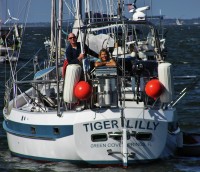
Who: Lilly and Tom Service
Port: Green Cove Springs

